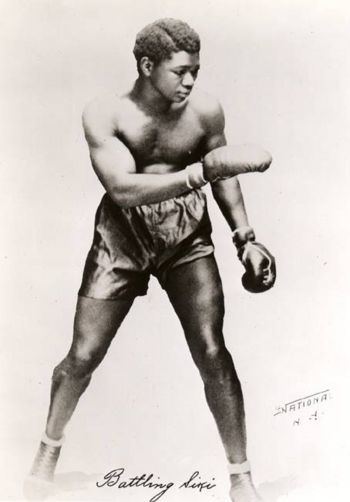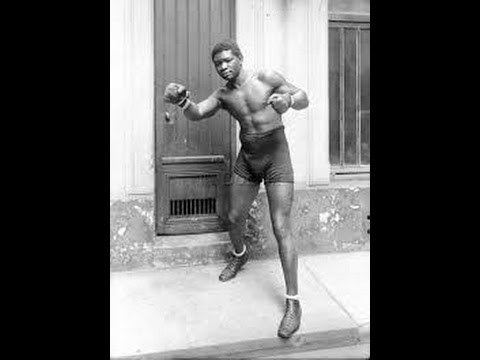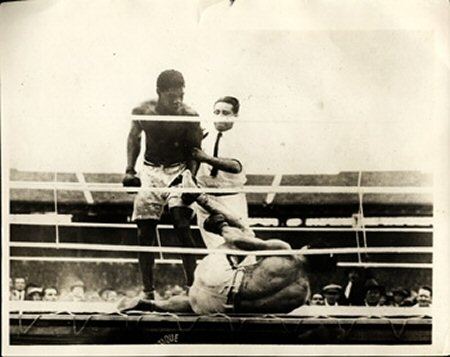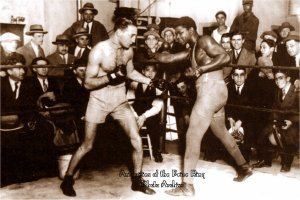Occupation boxer Martial art Boxing Height 1.79 m | Role Boxer Name Battling Siki | |
 | ||
People also search for Sassacus, Anthony Strollo, Vincent Mangano | ||
Georges carpentier vs battling siki full fight
Battling Siki (September 16, 1897 – December 15, 1925), aka Louis Mbarick Fall, was a French-Senegalese light heavyweight boxer born in Senegal who fought from 1912 to 1925, and briefly reigned as the World light heavyweight champion after knocking out Georges Carpentier.
Contents
- Georges carpentier vs battling siki full fight
- Georges carpentier vs battling siki
- Early years
- Post war career
- After the World title
- Murder
- Trivia
- References

Georges carpentier vs battling siki
Early years

He was born Baye Fall in the port city of Saint-Louis, Senegal. While still a teenager, Siki changed his name, and moved to metropolitan France, where, by the age of 15, he began his professional boxing career. Siki's early years were inauspicious. From 1912 to 1914 he compiled a record of just eight wins, six losses and two draws.

When World War I erupted, Siki joined the French army, serving in the 8th Colonial Infantry Regiment. During the war he was decorated for bravery in battle with the Croix de Guerre and the Médaille Militaire, before being honorably discharged.
Post-war career

After his discharge from the military, Siki resumed his boxing career. In October and November 1920 Siki boxed two matches in the Concertgebouw in Amsterdam, the Netherlands. He was romantically involved with a Dutch woman, Lijntje van Appelteer, who became his common-law wife. On December 16, 1921, she bore him a son, Louis Junior. In this period he taught boxing at the amateur boxing club De Jonge Bokser (The Young Boxer).

From November 1, 1919, until he faced Georges Carpentier for the world light heavyweight championship in 1922, Siki compiled the impressive record of 43 wins in 46 bouts (21 KOs), suffering just one loss (on a decision) and two draws. Carpentier, the reigning World and European champion, agreed to fight Siki for the title, and they met in Paris, France, on September 24, 1922.
Siki claimed that he had agreed to take a dive, but when Carpentier dropped Siki, the outraged African decided to get up and fight. Although he had agreed to throw the fight, he did not intend to get beat up doing so.
In the sixth round Siki hit Carpentier with a powerful right uppercut that appeared to put Carpentier down and out for the count. The referee, however, claimed Siki had tripped Carpentier, and awarded the bout to the unconscious champion on a foul. Fearing a riot from the aroused crowd, the three ringside judges overruled the referee, and Siki was eventually declared the champion.
Siki then embarked on a well publicized rampage of partying and carousing. He would walk his pet lion down the Champs-Élysées while wearing his top hat and tuxedo. Siki was known to fire his revolvers in the air in public as a means of prompting his two Great Danes to do tricks. He was constantly reported drinking champagne in night clubs, and spent freely on flashy clothes and partying. He was fond of white women, and both his wives were white.
During this time offers poured in from the United States for the colorful Siki to meet the leading heavyweight contender Harry Wills, middleweight champion Johnny Wilson, and the legendary Harry Greb. Attempts were even made to match Siki with the then reigning heavyweight champion Jack Dempsey.
Instead, Siki signed to defend his title against Irish light heavyweight Mike McTigue on Saint Patrick's Day in Dublin. The bout was controversial and Siki lost his belt on decision and lost the title. This defeat was the first loss in a downward trend of dissipation and poor ring performances suffered by Siki, which culminated in his death a little over a month after his last fight.
After the World title
After losing his European title on a foul, Siki moved to the United States. His record in the States was poor and he failed to defeat any top-notch fighters. His failure to train properly was evident; his record after winning the title was a dismal 11 wins (7 KOS), 17 losses, 1 draw and 2 No Contests. It was during this time period that he suffered the only two knockout defeats of his career. On July 23, he married artist Lillian Werner of Memphis, Tennessee, who was seven years his senior, in a civil marriage. Werner was registered as white, making theirs a rare mixed-race marriage at the time. At the time of his wedding, friends of Siki from France alleged that he was still married to a Dutch woman living in France who had born him a child two years earlier.
Even in the States Siki continued to carouse and train on booze and street brawls. Often, he would get drunk in speakeasies, refuse to pay the tab, and fight his way out.
Murder
On December 15, 1925, he was stopped by a policeman who saw him staggering drunk on 42nd Street, not far from his apartment in New York City. Siki stated that he was on his way home, and walked off. Later he was found lying face down, shot twice in the back at close range, dead at the age of 28.
The Rev. Adam Clayton Powell, the father of Adam Clayton Powell, Jr., presided over his funeral, which was held in Harlem New York. He was survived by his widow Lillian Werner Phal, whom he had married a year earlier. He was initially buried at Flushing Cemetery.
In 1993, his remains were repatriated to his home city of Saint-Louis, Senegal. His record was 64-25-5 with 35 knockouts.
